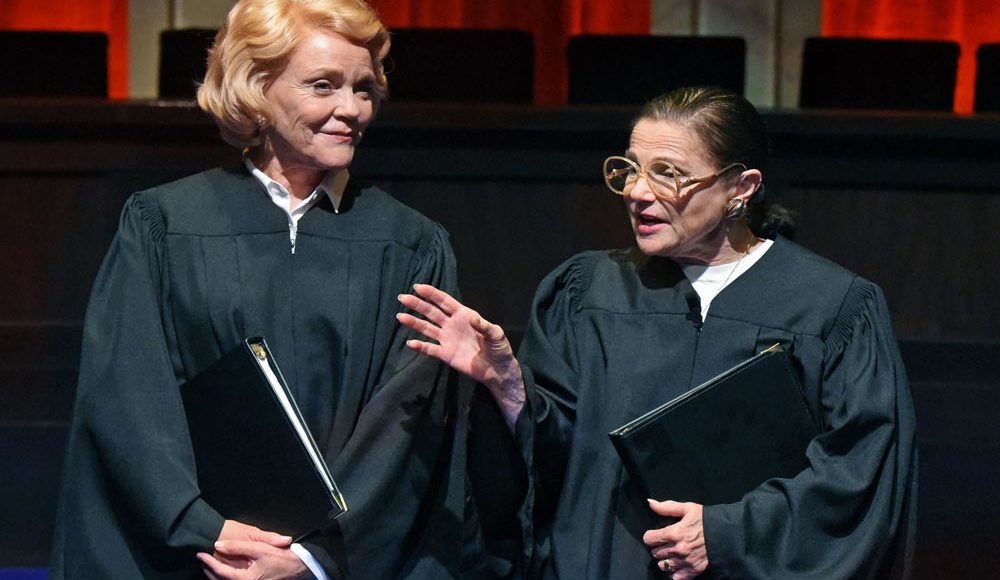By Ernest Kearney — Jonathan Shapiro’s Sisters In Law now at the Wallis is based on Linda Hirshman’s bestselling dual biography on Sandra Day O’Connor and Ruth Bader Ginsburg, the first and second women to serve on the Supreme Court.
Hirshman’s book juxtaposed the lives of O’Connor and Ginsburg the conservative Arizonian, the Jewish liberal New Yorker, and uses the stories of their ascent to the highest court in the land as a means to define and examine the struggle for women’s equality in this nation.
Shapiro’s play opens with a similar effort at juxtaposing the two justices’ lives, and the difficulties they each shared being women in the male dominated sphere of law. Graduating from Stanford Law School at a time when less than 2% of the nation’s law school students were women, O’Connor (Stephanie Faracy) relates how after forty job interviews where the firms told her they did not hire women, she finally received an offer of employment, as a legal secretary. She turned down that offer to open her own firm instead, which lead to government service and eventually the position of Majority Leader in the Arizona Senate; the first woman to obtain so high an office in a state legislature.
Ginsburg (Tovah Feldshuh), though a graduate of Harvard Law School, and bearing recommendations from its most illustrious teachers, found herself rejected for a clerkship by Supreme Court Justice Felix Frankfurter who told her bluntly, “I’m not hiring a woman.”
In 1981, fulfilling his campaign promise, President Ronald Reagan nominated O’Conner to become the first woman appointed to the Supreme Court.
With Ginsburg’s arrival to the Court, twelve years after O’Conner’s, Shapiro’s play brings the two together, contrasting both their personal styles and political differences.
“You want to change things fast,” O’Conner tells Ginsburg. “I want to change things slow. Men don’t want changes at all.”
Shapiro etches out the ideological chasm between the two women on the issues of sexual harassment and discrimination in the workplace, abortion and the need of activism on the part of the courts in dealing with crucial issues in the lives of women. With Ginsburg arguing,
“The law is not a follower, the law is a leader.”
We pass through Ginsburg’s 1999 surgery for colon cancer, and then pitch into O’Conner’s retirement from the court in 2006 in order to care for her husband incapacitated by the onset of Alzheimer’s. A decision Ginsburg derides by asking O’Conner when did any male justice leave the court to care for his spouse?
Shapiro closes his play in 2012 with the 30th anniversary celebration of O’Conner’s nomination to the Supreme Court. Ginsburg and O’Conner met backstage before joining Justices Elena Kagan and Sonia Sotomayor for the first appearance of all four together. There, despite their disparity in philosophies and politics, they share in the triumph that other women will follow them.
It was a crowd pleasing ending for a crowd pleasing show, and the crowd I was in attendance with was certainly very, very pleased.
Myself less so.
Shapiro has an impressive background as a television writer with credits extending over such notable series as The Firm, The Practice, and Boston Legal earning Emmys and other prestigious awards along the way.
But Sisters In Law is his first play, and frankly, it shows.
He starts off his piece with a succession of short rapid blackouts and continues on with them too long. Unfortunately the needs required of a dramatist cannot be delivered in the fashion of a semaphore telegraph.
Shapiro does himself and his effort a disservice in not honing down the focus of his drama sooner and into a sharper clarity.
The full title of Hirshman’s book is Sisters in Law: How Sandra Day O’Connor and Ruth Bader Ginsburg Went to the Supreme Court and Changed the World. Any attempt to cover the same ground; the backgrounds of O’Conner and Ginsburg, the former’s 24 years on the court, their initial relationship, their conflicting attitudes towards feminism, the friendship that developed between them, their distinct roles as “pioneer” and “radical” on both the bench and in the larger context of the Women’s Rights Movement that comprises the 416 pages of Hirshman’s work within a mere ninety minutes was a forlorn hope.
The resulting structure of the piece is rendered as a single, extended scene wedged in between two series of short vignettes.
Thus truncated, the impact of the narrative is reduced to that of flashcards, and the performances of two fine actresses restricted to merely that of excellent characterizations.
Director Patricia McGregor undertakes to blithely pass over the shortfalls of the piece, but I can’t say I found her labors effective.
Again, let me confess that my lukewarm reaction was not shared by the audience as a whole. But their enthusiasm did feel to me like that poured out in the last minutes of the final quarter when the hometown team is down by twenty points.
♦ ♦ ♦
(Featured Image Information: Sisters In Law starring Tovah Feldshuh as Ruth Bader Ginsburg and Stephanie Faracy as Sandra Day O’Connor. Photo by Kevin Parry.)
Wallis Annenberg Center for the Performing Arts
In Association with Elizabeth Weber, Dale Franzen and Don Franzen
Presents the West Coast Premiere of
Sisters In Law
at
Wallis Annenberg Center for the Performing Arts
Lovelace Studio Theater
9390 N. Santa Monica Boulevard
Beverly Hills, CA 90210
Dates Playing:
Wednesday, September 18 through Sunday, October 13, 2019
Saturdays, 2:30 pm and 8 pm; Sundays, 2:30 pm and 7:30 pm
For Tickets and More Information Go To:
Phone:
310.746.4000
Box Office – Wallis Annenberg Center for the Performing Arts Ticket Services
9390 N. Santa Monica Blvd, Beverly Hills, CA, 90210





